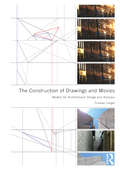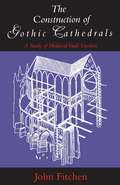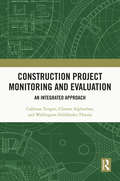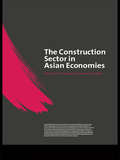- Table View
- List View
Construction Health and Safety in Developing Countries (Spon Research)
by Patrick Manu Fidelis Emuze Tarcisio Abreu Saurin Bonaventura H. W. HadikusumoThe global construction sector is infamous for high levels of injuries, accidents and fatalities, and poor health and well-being of its workforce. While this record appears in both developed and developing countries, the situation is worse in developing countries, where major spending on infrastructure development is expected. There is an urgent need to improve construction health and safety (H&S) in developing countries. The improvement calls for the development of context-specific solutions underpinned by research into challenges and related solutions. This edited volume advances the current understanding of construction H&S in developing countries by revealing context-specific issues and challenges that have hitherto not been well explored in the literature, and applying emergent H&S management approaches and practices in developing countries. Coverage includes countries from the regions of sub-Saharan Africa, Latin America, Asia and Europe. This book, which is the first compendium of research into construction H&S issues in developing countries, adds considerable insight into the field and presents innovative solutions to help address poor H&S in construction in developing nations. It is a must read for all construction professionals, researchers and practitioners interested in construction and occupational H&S, safety management, engineering management and development studies.
Construction Knitting: Knitwear Design With Geometric Shapes
by Nikki GabrielBecome the co-designer of your own knitwear, with Construction Knitting.Using a combination of flat and drape patternmaking, Nikki Gabriel's easy-to-follow technique takes an accumulative approach to garment making, assembling knitwear from individually crafted geometric shapes. Readers are guided through each stage: from creating and assembling the shapes to adapting your garments to fit your unique style. Section one covers knitting techniques for fabric structure and composition, along with yarn specifications, while section two delves into the methodology behind construction knitting.With photographic and illustrated demonstrations, easy-to-follow step-by-step instructions, and clear hand-knitting methods, Construction Knitting is well-suited to students, designers and amateur knitters alike.
Construction Knitting: Knitwear Design With Geometric Shapes
by Nikki GabrielBecome the co-designer of your own knitwear, with Construction Knitting.Using a combination of flat and drape patternmaking, Nikki Gabriel's easy-to-follow technique takes an accumulative approach to garment making, assembling knitwear from individually crafted geometric shapes. Readers are guided through each stage: from creating and assembling the shapes to adapting your garments to fit your unique style. Section one covers knitting techniques for fabric structure and composition, along with yarn specifications, while section two delves into the methodology behind construction knitting.With photographic and illustrated demonstrations, easy-to-follow step-by-step instructions, and clear hand-knitting methods, Construction Knitting is well-suited to students, designers and amateur knitters alike.
Construction Management: Theory and Practice
by Chris MarchConstruction Management: Theory and Practice is a comprehensive textbook for budding construction managers. The range of coverage makes the book essential reading for students studying management courses in all construction related disciplines and ideal reading for those with non-cognate degrees studying construction management masters courses, giving them a broad base of understanding about the industry. Part I outlines the main industry players and their roles in relation to the Construction Manager. Part II covers management theory, leadership and team working strategies. Part III details financial aspects including: sources of finance, appraisal and estimating, construction economics, whole life costing and life cycle analysis, bidding and tendering as well as procurement methods, types of contracts and project costing. Part IV covers construction operations management and issues such as supply chain management, health and safety, waste, quality and environmental management. Part V covers issues such as marketing, strategy, HRM, health, stress and well-being. Part VI concludes the book with reflections on the future of the industry in relation to the environment and sustainability and the role of the industry and its managers. The book keeps the discussion of current hot topics such as building information modelling (BIM), sustainability, and health and well-being included throughout and is packed with useful figures, tables and case studies from industry.
Construction Management: Theory and Practice
by Chris MarchConstruction Management: Theory and Practice is a comprehensive textbook for budding construction managers. The range of coverage makes the book essential reading for students studying management courses in all construction related disciplines and ideal reading for those with non-cognate degrees studying construction management masters courses, giving them a broad base of understanding about the industry. Part I outlines the main industry players and their roles in relation to the Construction Manager. Part II covers management theory, leadership and team working strategies. Part III details financial aspects including: sources of finance, appraisal and estimating, construction economics, whole life costing and life cycle analysis, bidding and tendering as well as procurement methods, types of contracts and project costing. Part IV covers construction operations management and issues such as supply chain management, health and safety, waste, quality and environmental management. Part V covers issues such as marketing, strategy, HRM, health, stress and well-being. Part VI concludes the book with reflections on the future of the industry in relation to the environment and sustainability and the role of the industry and its managers. The book keeps the discussion of current hot topics such as building information modelling (BIM), sustainability, and health and well-being included throughout and is packed with useful figures, tables and case studies from industry.
Construction Manager's BIM Handbook
by John EynonBuilding Information Modelling (BIM) harnesses digital technologies to unlock more efficient methods of designing, creating and maintaining built environment assets, so the Construction Manager’s BIM Handbook ensures the reader understands what BIM is, what the UK strategy is and what it means for key roles in the construction team. ensure that all readers understand what BIM and are fully aware of the implications of BIM for them and their organisations provides concise summaries of key aspects of BIM ensure that all readers can begin to adopt this approach in future projects includes industry case studies illustrating the use of BIM on large and small projects
Construction Manager's BIM Handbook
by John EynonBuilding Information Modelling (BIM) harnesses digital technologies to unlock more efficient methods of designing, creating and maintaining built environment assets, so the Construction Manager’s BIM Handbook ensures the reader understands what BIM is, what the UK strategy is and what it means for key roles in the construction team. ensure that all readers understand what BIM and are fully aware of the implications of BIM for them and their organisations provides concise summaries of key aspects of BIM ensure that all readers can begin to adopt this approach in future projects includes industry case studies illustrating the use of BIM on large and small projects
Construction Methods and Planning
by J. R. IllingworthThis new edition of John Illingworth's popular book provides a thorough introduction to the selection of construction methods, their planning and organization on site. Thoroughly revised and updated, Construction Methods and Planning takes a practical, down-to-earth approach and features numerous examples and illustrations taken from real situations and sites. In Part One, the main factors which determine the planning of construction methods - site inspections, the site itself, temporary works, design, cost concepts and selection of plant and methods - are discussed. In Part Two, the application of these tools is presented, covering foundations and basements, in situ and precast concrete structures, steel frames, cladding, internal and external works, waste, methods statements, contract planning control and claims. The author provides an extension of the concept of 'buildability' and new chapters on facade retention and the refurbishment of domestic accommodation.
Construction Methods and Planning
by J.R. IllingworthThis new edition of John Illingworth's popular book provides a thorough introduction to the selection of construction methods, their planning and organization on site. Thoroughly revised and updated, Construction Methods and Planning takes a practical, down-to-earth approach and features numerous examples and illustrations taken from real situations and sites. In Part One, the main factors which determine the planning of construction methods - site inspections, the site itself, temporary works, design, cost concepts and selection of plant and methods - are discussed. In Part Two, the application of these tools is presented, covering foundations and basements, in situ and precast concrete structures, steel frames, cladding, internal and external works, waste, methods statements, contract planning control and claims. The author provides an extension of the concept of 'buildability' and new chapters on facade retention and the refurbishment of domestic accommodation.
The Construction of Drawings and Movies: Models for Architectural Design and Analysis
by Thomas ForgetThe architectural imagery that you create is most effective when it examines your project in an abstract manner. Most students and practitioners understand linear perspective and cinema to be examples of architectural presentation tools. This book asks you to consider drawings and movies to be analytical tools that give you the capacity to engage all phases of the design process, from parti to presentation. The ways in which spaces relate to each other and how materials connect to each other in your projects are as important as your building’s appearance. As digital tools increasingly allow you to simulate the experience of built and unbuilt environments, it is essential that you scrutinize the nature of architectural imagery and resist the lure of virtual reality. Though pure simulation may be appropriate for your clients, your design process requires abstraction and analysis. Author Thomas Forget demonstrates how to construct analytical drawings and movies that challenge the alleged realism of linear perspective and cinema. These demonstrations expose you to underlying principles that will allow you to understand the broader implications of these methods. In addition, historical surveys of drawings and movies provide you with insight into how architects and architectural historians have understood the role of linear perspective and cinema in their fields. Finally, examples of drawing and moviemaking strategies illustrate how you can apply the lessons of the book to precedent analyses and design projects.
The Construction of Drawings and Movies: Models for Architectural Design and Analysis
by Thomas ForgetThe architectural imagery that you create is most effective when it examines your project in an abstract manner. Most students and practitioners understand linear perspective and cinema to be examples of architectural presentation tools. This book asks you to consider drawings and movies to be analytical tools that give you the capacity to engage all phases of the design process, from parti to presentation. The ways in which spaces relate to each other and how materials connect to each other in your projects are as important as your building’s appearance. As digital tools increasingly allow you to simulate the experience of built and unbuilt environments, it is essential that you scrutinize the nature of architectural imagery and resist the lure of virtual reality. Though pure simulation may be appropriate for your clients, your design process requires abstraction and analysis. Author Thomas Forget demonstrates how to construct analytical drawings and movies that challenge the alleged realism of linear perspective and cinema. These demonstrations expose you to underlying principles that will allow you to understand the broader implications of these methods. In addition, historical surveys of drawings and movies provide you with insight into how architects and architectural historians have understood the role of linear perspective and cinema in their fields. Finally, examples of drawing and moviemaking strategies illustrate how you can apply the lessons of the book to precedent analyses and design projects.
The Construction of Gothic Cathedrals: A Study of Medieval Vault Erection
by John FitchenJohn Fitchen systematically treats the process of erecting the great edifices of the Gothic era. He explains the building equipment and falsework needed, the actual operations undertaken, and the sequence of these operations as specifically as they can be deduced today. Since there are no contemporary accounts of the techniques used by medieval builders, Fitchen's study brilliantly pieces together clues from manuscript illuminations, from pictorial representations, and from the fabrics of the building themselves. "Anyone who has caught the fascination of Gothic Churches (and once caught, has almost necessarily got it in the blood) will find this book enthralling. . . . Clearly written and beautifully illustrated." —A. D. R. Caroe, Annual Review, Central Council for the Care of Churches "Fitchen's study is a tribute to the extraordinary creative and engineering skills of successive generations of mediaeval builders. . . . This study enables us to appreciate more fully the technical expertise and improvements which enabled the creative spirit of the day to find such splendid embodiment." —James Lingwood, Oxford Art Journal "Fitchen, in what can only be defined as an architectural detective story, fully explores the problems confronting the medieval vault erectors and uncovers their solution. . . . This is a book that no serious student of architecture will want to miss." —Progressive Architecture
Construction of the Façade Systems: Production and Assembly Procedures of the Advanced Building Envelopes (SpringerBriefs in Applied Sciences and Technology)
by Ingrid Paoletti Massimiliano NastriThe book explores the advanced façade systems according to the productive and constructive contents, in a cognitive and operative form, as a manual text to provide guidelines for researchers, technicians and professionals. It provides operational guidance for the technological design, production planning and site executive coordination for the realization of façade systems. The analysis deals with the main building elements and technical interfaces. The study of the façade systems, after explaining the anchoring structures and their connections to the load-bearing elements, investigates the criteria for the assembly between the framings. In particular, the book examines the technical interfaces of the main advanced envelope systems with respect to the functional, constructive and applicative coordination procedures of the mullions and transoms framing, of the structural sealant glazing façade system, of the unit façade system, of the suspended façade system and of the double skin façade system. The technical and manual character of the book is also expressed through the analysis of the functional and application procedures of the gaskets with respect to the façade systems in order to prevent the transmission of air and water loads: the analysis focuses on the connections between the framing and the enclosure elements of the envelope, in accordance with the compensation of height differences in order to guarantee impermeability, airtightness and insulation. Then, the book describes the assembly and interface conditions between elements of different composition and production within the façade systems: the examination of the technical interfaces involves the development and application of sealants, based on the loads exerted on the jointing devices, in order to fulfill the requirements of sealing and tightness with respect to mechanical, thermal and hygrometric, water, air and wind stresses. Moreover, the study of the envelope systems examines the methodologies directed toward fulfilling the requirements with respect to the actions caused by fire loads, considering the contents related to both components and connections and fixing surfaces.
Construction Project Manager’s Pocket Book (Routledge Pocket Books)
by Duncan CartlidgeThe third edition of the Construction Project Manager’s Pocket Book continues to guide and educate readers on the broad range of essential skills required to be a successful construction project manager. The book introduces the generic skills required by any project manager, before tackling the core skills and activities of a construction project manager with direct reference to the RIBA Plan of Work and the OGC Gateway. Key features and coverage in the new edition include:· a step-by-step explanation of construction project management from pre-construction to occupancy,· hard and soft skills, including ethics, leadership, team building,· procurement strategies,· supply chain and contract management,· feasibility studies / development appraisals,· environmental issues,· digital tools and· occupancy activities.The updates in this new edition take account of all regulatory and legislative changes, and also changing market conditions and working trends. This is the ideal concise reference that no project manager, construction manager, architect or quantity surveyor should be without.
Construction Project Manager’s Pocket Book (Routledge Pocket Books)
by Duncan CartlidgeThe third edition of the Construction Project Manager’s Pocket Book continues to guide and educate readers on the broad range of essential skills required to be a successful construction project manager. The book introduces the generic skills required by any project manager, before tackling the core skills and activities of a construction project manager with direct reference to the RIBA Plan of Work and the OGC Gateway. Key features and coverage in the new edition include:· a step-by-step explanation of construction project management from pre-construction to occupancy,· hard and soft skills, including ethics, leadership, team building,· procurement strategies,· supply chain and contract management,· feasibility studies / development appraisals,· environmental issues,· digital tools and· occupancy activities.The updates in this new edition take account of all regulatory and legislative changes, and also changing market conditions and working trends. This is the ideal concise reference that no project manager, construction manager, architect or quantity surveyor should be without.
Construction Project Monitoring and Evaluation: An Integrated Approach (Routledge Research Collections for Construction in Developing Countries)
by Callistus Tengan Clinton Aigbavboa Wellington Didibhuku ThwalaThis book will provide readers with an in-depth theoretical awareness and practical guidance on the implementation of an effective monitoring and evaluation (M&E) system to ensure construction projects meet approved quality, cost, time and social sustainability objectives. The authors discuss the drivers, challenges, determinants and benefits of effective M&E implementation together with the theories and models underpinning construction project M&E practices. Further, a comparative overview of M&E practices in developed and developing countries is presented to elucidate the best practices. The book first conceptualizes M&E as a five-factor model comprising stakeholder involvement, budgetary allocation and logistics, technical capacity and training, leadership, and communication. It then presents an M&E case study on the Ghanaian construction industry before expanding on the idea of M&E systems as an effective tool for project performance and in optimizing a project’s contribution to society and the environment. The book further provides guidance on M&E practice for construction project managers, investors, professionals, researchers and other stakeholders and is therefore of interest to those in architecture, construction engineering, planning, project management and development studies.
Construction Project Monitoring and Evaluation: An Integrated Approach (Routledge Research Collections for Construction in Developing Countries)
by Callistus Tengan Clinton Aigbavboa Wellington Didibhuku ThwalaThis book will provide readers with an in-depth theoretical awareness and practical guidance on the implementation of an effective monitoring and evaluation (M&E) system to ensure construction projects meet approved quality, cost, time and social sustainability objectives. The authors discuss the drivers, challenges, determinants and benefits of effective M&E implementation together with the theories and models underpinning construction project M&E practices. Further, a comparative overview of M&E practices in developed and developing countries is presented to elucidate the best practices. The book first conceptualizes M&E as a five-factor model comprising stakeholder involvement, budgetary allocation and logistics, technical capacity and training, leadership, and communication. It then presents an M&E case study on the Ghanaian construction industry before expanding on the idea of M&E systems as an effective tool for project performance and in optimizing a project’s contribution to society and the environment. The book further provides guidance on M&E practice for construction project managers, investors, professionals, researchers and other stakeholders and is therefore of interest to those in architecture, construction engineering, planning, project management and development studies.
Construction Quality Management: Principles and Practice
by Tim Howarth David GreenwoodQuality management is essential for facilitating the competitiveness of modern day commercial organisations. Excellence in quality management is a requisite for construction organisations who seek to remain competitive and successful. The challenges presented by competitive construction markets and large projects that are dynamic and complex necessitate the adoption and application of quality management approaches. This new edition of Construction Quality Management provides a comprehensive evaluation of quality management systems and tools. Their effectiveness in achieving project objectives is explored, as well as applications in corporate performance enhancement. Both the strategic and operational dimensions of quality assurance are addressed by focusing on providing models of best practice. The reader is supported throughout by concise and clear explanations and with self-assessment questions. Practical case study examples show how various evaluative-based quality management systems and tools have been applied. Subjects covered include: business objectives – the stakeholder satisfaction methodology organisational culture and Health and Safety quality philosophy evaluation of organisational performance continuous quality improvement and development of a learning organisation. New chapters consider the influence of Building Information Modelling (BIM) on quality management. The text should be of interest to construction industry senior managers, practicing professionals and academics. It is also an essential resource for undergraduate and postgraduate students of construction management, project management and business management courses.
Construction Quality Management: Principles and Practice
by Tim Howarth David GreenwoodQuality management is essential for facilitating the competitiveness of modern day commercial organisations. Excellence in quality management is a requisite for construction organisations who seek to remain competitive and successful. The challenges presented by competitive construction markets and large projects that are dynamic and complex necessitate the adoption and application of quality management approaches. This new edition of Construction Quality Management provides a comprehensive evaluation of quality management systems and tools. Their effectiveness in achieving project objectives is explored, as well as applications in corporate performance enhancement. Both the strategic and operational dimensions of quality assurance are addressed by focusing on providing models of best practice. The reader is supported throughout by concise and clear explanations and with self-assessment questions. Practical case study examples show how various evaluative-based quality management systems and tools have been applied. Subjects covered include: business objectives – the stakeholder satisfaction methodology organisational culture and Health and Safety quality philosophy evaluation of organisational performance continuous quality improvement and development of a learning organisation. New chapters consider the influence of Building Information Modelling (BIM) on quality management. The text should be of interest to construction industry senior managers, practicing professionals and academics. It is also an essential resource for undergraduate and postgraduate students of construction management, project management and business management courses.
Construction Safety Management Systems
by Steve RowlinsonThe construction industry has a distressingly poor safety record, whether measured in absolute terms or alongside other industries. The level of construction safety in a country is influenced by factors such as variations in the labour forces, shifting economies, insurance rates, legal ramifications and the stage of technological development. Yet the problem is a world-wide one, and many of the ways of tackling it can be applied across countries. Effective tools include designing, preplanning, training, management commitment and the development of a safety culture. The introduction and operation of effective safety management systems represents a viable way forwards, but these systems are all too rarely implemented. How can this be done? Should we go back to prescriptive legislation? This book considers these questions by drawing together leading-edge research papers from the proceedings of an international conference conducted by a commission (W099) on Safety and Health on Construction Sites of CIB, the international council of building research organisations.
Construction Safety Management Systems
by Steve RowlinsonThe construction industry has a distressingly poor safety record, whether measured in absolute terms or alongside other industries. The level of construction safety in a country is influenced by factors such as variations in the labour forces, shifting economies, insurance rates, legal ramifications and the stage of technological development. Yet the problem is a world-wide one, and many of the ways of tackling it can be applied across countries. Effective tools include designing, preplanning, training, management commitment and the development of a safety culture. The introduction and operation of effective safety management systems represents a viable way forwards, but these systems are all too rarely implemented. How can this be done? Should we go back to prescriptive legislation? This book considers these questions by drawing together leading-edge research papers from the proceedings of an international conference conducted by a commission (W099) on Safety and Health on Construction Sites of CIB, the international council of building research organisations.
The Construction Sector in the Asian Economies
by Michael Anson Y.H. Chiang John RafteryThis collection of essential data on eleven Asian economies outlines new trends and highlighting increasing differences between developed and developing countries. The book features a detailed analysis of the state of the construction industry and its economic effects in Australia, China Mainland, China Hong Kong, India, Indonesia, Japan, South Korea, Philippines, Singapore, Sri Lanka and Vietnam.
The Construction Sector in the Asian Economies
by Michael Anson Y.H. Chiang John RafteryThis collection of essential data on eleven Asian economies outlines new trends and highlighting increasing differences between developed and developing countries. The book features a detailed analysis of the state of the construction industry and its economic effects in Australia, China Mainland, China Hong Kong, India, Indonesia, Japan, South Korea, Philippines, Singapore, Sri Lanka and Vietnam.
Construction Specifications Writing: Principles and Procedures (Wiley Desktop Editions Ser.)
by Mark Kalin Robert S. Weygant Harold J. Rosen John R. RegenerUpdated edition of the comprehensive rulebook to the specifier's craft With this latest update, Construction Specifications Writing, Sixth Edition continues to claim distinction as the foremost text on construction specifications. This mainstay in the field offers comprehensive, practical, and professional guidance to understanding the purposes and processes for preparation of construction specifications. This new edition uses real-world document examples that reflect current writing practices shaped by the well-established principles and requirements of major professional associations, including the American Institute of Architects (AIA), the Engineers Joint Contract Documents Committee (EJCDC), and the Construction Specifications Institute (CSI). Also included are guidelines for correct terminology, product selection, organization of specifications according to recognized CSI formats, and practical techniques for document production. Fully revised throughout, this Sixth Edition includes: Updates to MasterFormat 2004, as well as SectionFormat/PageFormat 2007 and Uniformat End-of-chapter questions and specification-writing exercises Samples of the newly updated construction documents from the AIA New chapter on sustainable design and specifications for LEED projects Updated information on the role of specifications in Building Information Modeling (BIM)
Construction Specifications Writing: Principles and Procedures
by Mark Kalin Robert S. Weygant Harold J. Rosen John R. RegenerUpdated edition of the comprehensive rulebook to the specifier's craft With this latest update, Construction Specifications Writing, Sixth Edition continues to claim distinction as the foremost text on construction specifications. This mainstay in the field offers comprehensive, practical, and professional guidance to understanding the purposes and processes for preparation of construction specifications. This new edition uses real-world document examples that reflect current writing practices shaped by the well-established principles and requirements of major professional associations, including the American Institute of Architects (AIA), the Engineers Joint Contract Documents Committee (EJCDC), and the Construction Specifications Institute (CSI). Also included are guidelines for correct terminology, product selection, organization of specifications according to recognized CSI formats, and practical techniques for document production. Fully revised throughout, this Sixth Edition includes: Updates to MasterFormat 2004, as well as SectionFormat/PageFormat 2007 and Uniformat End-of-chapter questions and specification-writing exercises Samples of the newly updated construction documents from the AIA New chapter on sustainable design and specifications for LEED projects Updated information on the role of specifications in Building Information Modeling (BIM)














